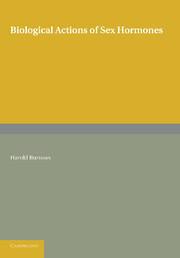Book contents
- Frontmatter
- CONTENTS
- PREFACE
- PART I GONADOTROPHINS
- PART II GONADAL HORMONES
- PART III ANDROGENS
- CHAPTER VI Androgens
- CHAPTER VII The Action of Androgen on the Reproductive Organs before their Complete Differentiation
- CHAPTER VIII The Action of Androgen on the Reproductive Organs after their Complete Differentiation
- CHAPTER IX The Action of Androgen on the Accessory Generative Organs
- CHAPTER X The Action of Androgen on Tissues and Organs other than those already dealt with
- PART IV OESTROGENS
- PART V PROGESTINS
- PART VI SEX HORMONES OF THE ADRENAL CORTEX
- APPENDIX
- REFERENCES
- GLOSSARY
- INDEX
CHAPTER VIII - The Action of Androgen on the Reproductive Organs after their Complete Differentiation
from PART III - ANDROGENS
Published online by Cambridge University Press: 05 June 2016
- Frontmatter
- CONTENTS
- PREFACE
- PART I GONADOTROPHINS
- PART II GONADAL HORMONES
- PART III ANDROGENS
- CHAPTER VI Androgens
- CHAPTER VII The Action of Androgen on the Reproductive Organs before their Complete Differentiation
- CHAPTER VIII The Action of Androgen on the Reproductive Organs after their Complete Differentiation
- CHAPTER IX The Action of Androgen on the Accessory Generative Organs
- CHAPTER X The Action of Androgen on Tissues and Organs other than those already dealt with
- PART IV OESTROGENS
- PART V PROGESTINS
- PART VI SEX HORMONES OF THE ADRENAL CORTEX
- APPENDIX
- REFERENCES
- GLOSSARY
- INDEX
Summary
The Gonads
Ovary and Testis.
THE writer has already discussed the action of androgens on individual organs before their complete differentiation. The purpose of this separation is to distinguish between the early, often permanent, effects, and the usually transient, reversible effects which androgens induce at a later stage in the life of the reproductive organs. The distinction between the two groups is not quite logical, for there is no sharply defined boundary between them. Nevertheless, in connection with human pathology and treatment—which are in the mind of the writer throughout this essay—the distinction is important; and any overlapping of thought or repetition of narrative which the arrangement entails will, the writer hopes, be forgiven.
For a long while after birth, and in some instances throughout life, the sexual characters have not assumed a fixed and final form, and some of the responses to androgen, even in late postnatal existence, are irreversible and permanent, or nearly so.
I. THE OVARY
(a) Gonadotrophic action. The first effect of androgen on the ovary of the immature animal, and perhaps on that of the adult, is an acceleration of follicular maturation. A comparable initial effect is exercised by androgens on the testis as shown by a favourable influence on spermatogenesis (p. 198).
Shapiro (1936) reported that ovulation could be induced in the clawed toad (Xenopus laevis) by various androgens as well as progesterone; and adrenal cortical extract also had this effect. The reaction was obtained even though the pituitary had been previously removed. Ovulation was not obtained in Shapiro's experiments with oestrogens; the doses of these mentioned in his paper are very large —10 mg. of oestrone and 8 mg. of oestradiol. Dantchakoff (19386) observed the formation of multiple follicular cysts in the ovaries of young guinea-pigs which had been subjected to testosterone. The condition, she says, resembles that produced by FRH, namely the simultaneous maturation of many follicles which, failing to rupture or to undergo luteinization, remain as cysts. Salmon (19386) gave single injections of 1 to 5 mg. of testosterone propionate or androstenediol in sesame oil to twelve female rats 17-30 days old. To six female rats of the same age he gave sesame oil only.
- Type
- Chapter
- Information
- Biological Actions of Sex Hormones , pp. 191 - 206Publisher: Cambridge University PressPrint publication year: 2013

